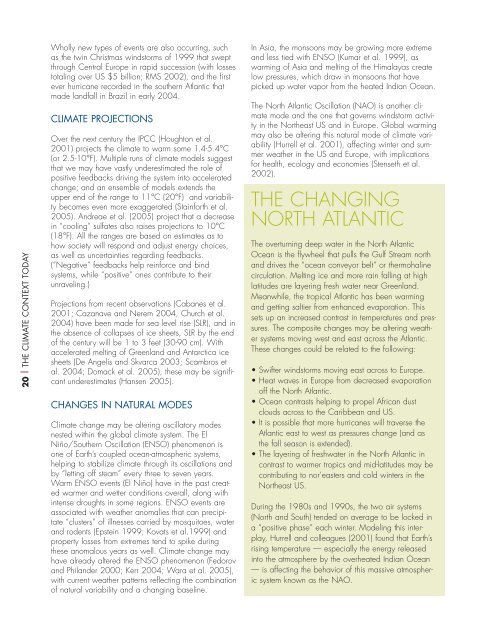Climate change futures: health, ecological and economic dimensions
Climate change futures: health, ecological and economic dimensions
Climate change futures: health, ecological and economic dimensions
You also want an ePaper? Increase the reach of your titles
YUMPU automatically turns print PDFs into web optimized ePapers that Google loves.
20 | THE CLIMATE CONTEXT TODAY<br />
Wholly new types of events are also occurring, such<br />
as the twin Christmas windstorms of 1999 that swept<br />
through Central Europe in rapid succession (with losses<br />
totaling over US $5 billion; RMS 2002), <strong>and</strong> the first<br />
ever hurricane recorded in the southern Atlantic that<br />
made l<strong>and</strong>fall in Brazil in early 2004.<br />
CLIMATE PROJECTIONS<br />
Over the next century the IPCC (Houghton et al.<br />
2001) projects the climate to warm some 1.4-5.4°C<br />
(or 2.5-10°F). Multiple runs of climate models suggest<br />
that we may have vastly underestimated the role of<br />
positive feedbacks driving the system into accelerated<br />
<strong>change</strong>; <strong>and</strong> an ensemble of models extends the<br />
upper end of the range to 11°C (20°F) <strong>and</strong> variability<br />
becomes even more exaggerated (Stainforth et al.<br />
2005). Andreae et al. (2005) project that a decrease<br />
in “cooling” sulfates also raises projections to 10°C<br />
(18°F). All the ranges are based on estimates as to<br />
how society will respond <strong>and</strong> adjust energy choices,<br />
as well as uncertainties regarding feedbacks.<br />
(“Negative” feedbacks help reinforce <strong>and</strong> bind<br />
systems, while “positive” ones contribute to their<br />
unraveling.)<br />
Projections from recent observations (Cabanes et al.<br />
2001; Cazanave <strong>and</strong> Nerem 2004, Church et al.<br />
2004) have been made for sea level rise (SLR), <strong>and</strong> in<br />
the absence of collapses of ice sheets, SLR by the end<br />
of the century will be 1 to 3 feet (30-90 cm). With<br />
accelerated melting of Greenl<strong>and</strong> <strong>and</strong> Antarctica ice<br />
sheets (De Angelis <strong>and</strong> Skvarca 2003; Scambros et<br />
al. 2004; Domack et al. 2005), these may be significant<br />
underestimates (Hansen 2005).<br />
CHANGES IN NATURAL MODES<br />
<strong>Climate</strong> <strong>change</strong> may be altering oscillatory modes<br />
nested within the global climate system. The El<br />
Niño/Southern Oscillation (ENSO) phenomenon is<br />
one of Earth’s coupled ocean-atmospheric systems,<br />
helping to stabilize climate through its oscillations <strong>and</strong><br />
by “letting off steam” every three to seven years.<br />
Warm ENSO events (El Niño) have in the past created<br />
warmer <strong>and</strong> wetter conditions overall, along with<br />
intense droughts in some regions. ENSO events are<br />
associated with weather anomalies that can precipitate<br />
“clusters” of illnesses carried by mosquitoes, water<br />
<strong>and</strong> rodents (Epstein 1999; Kovats et al.1999) <strong>and</strong><br />
property losses from extremes tend to spike during<br />
these anomalous years as well. <strong>Climate</strong> <strong>change</strong> may<br />
have already altered the ENSO phenomenon (Fedorov<br />
<strong>and</strong> Phil<strong>and</strong>er 2000; Kerr 2004; Wara et al. 2005),<br />
with current weather patterns reflecting the combination<br />
of natural variability <strong>and</strong> a changing baseline.<br />
In Asia, the monsoons may be growing more extreme<br />
<strong>and</strong> less tied with ENSO (Kumar et al. 1999), as<br />
warming of Asia <strong>and</strong> melting of the Himalayas create<br />
low pressures, which draw in monsoons that have<br />
picked up water vapor from the heated Indian Ocean.<br />
The North Atlantic Oscillation (NAO) is another climate<br />
mode <strong>and</strong> the one that governs windstorm activity<br />
in the Northeast US <strong>and</strong> in Europe. Global warming<br />
may also be altering this natural mode of climate variability<br />
(Hurrell et al. 2001), affecting winter <strong>and</strong> summer<br />
weather in the US <strong>and</strong> Europe, with implications<br />
for <strong>health</strong>, ecology <strong>and</strong> economies (Stenseth et al.<br />
2002).<br />
THE CHANGING<br />
NORTH ATLANTIC<br />
The overturning deep water in the North Atlantic<br />
Ocean is the flywheel that pulls the Gulf Stream north<br />
<strong>and</strong> drives the “ocean conveyor belt” or thermohaline<br />
circulation. Melting ice <strong>and</strong> more rain falling at high<br />
latitudes are layering fresh water near Greenl<strong>and</strong>.<br />
Meanwhile, the tropical Atlantic has been warming<br />
<strong>and</strong> getting saltier from enhanced evaporation. This<br />
sets up an increased contrast in temperatures <strong>and</strong> pressures.<br />
The composite <strong>change</strong>s may be altering weather<br />
systems moving west <strong>and</strong> east across the Atlantic.<br />
These <strong>change</strong>s could be related to the following:<br />
• Swifter windstorms moving east across to Europe.<br />
• Heat waves in Europe from decreased evaporation<br />
off the North Atlantic.<br />
• Ocean contrasts helping to propel African dust<br />
clouds across to the Caribbean <strong>and</strong> US.<br />
• It is possible that more hurricanes will traverse the<br />
Atlantic east to west as pressures <strong>change</strong> (<strong>and</strong> as<br />
the fall season is extended).<br />
• The layering of freshwater in the North Atlantic in<br />
contrast to warmer tropics <strong>and</strong> mid-latitudes may be<br />
contributing to nor’easters <strong>and</strong> cold winters in the<br />
Northeast US.<br />
During the 1980s <strong>and</strong> 1990s, the two air systems<br />
(North <strong>and</strong> South) tended on average to be locked in<br />
a “positive phase” each winter. Modeling this interplay,<br />
Hurrell <strong>and</strong> colleagues (2001) found that Earth’s<br />
rising temperature — especially the energy released<br />
into the atmosphere by the overheated Indian Ocean<br />
— is affecting the behavior of this massive atmospheric<br />
system known as the NAO.

















